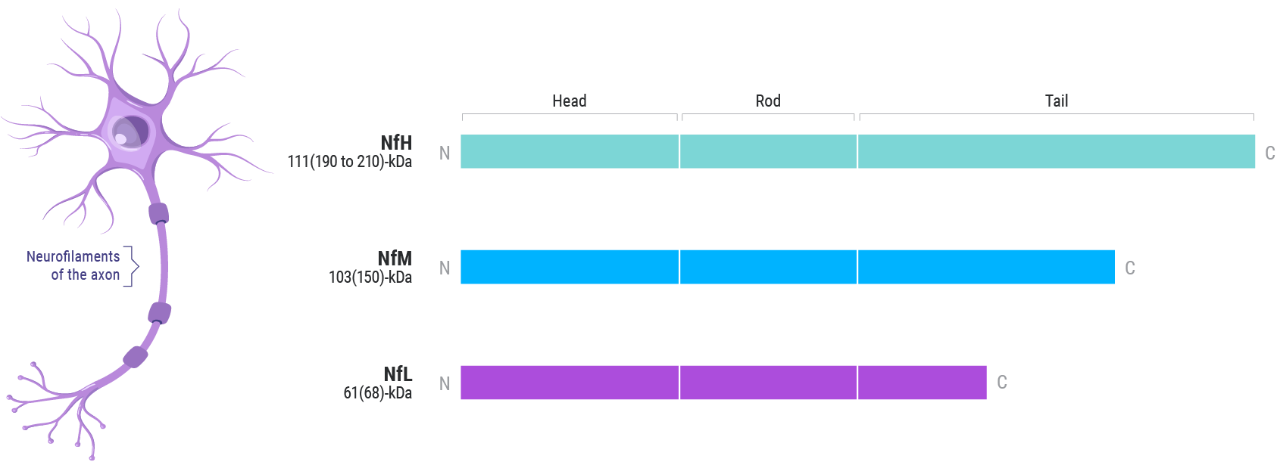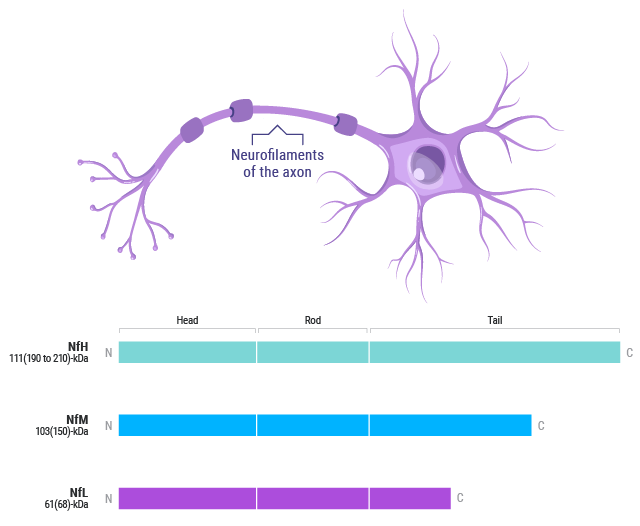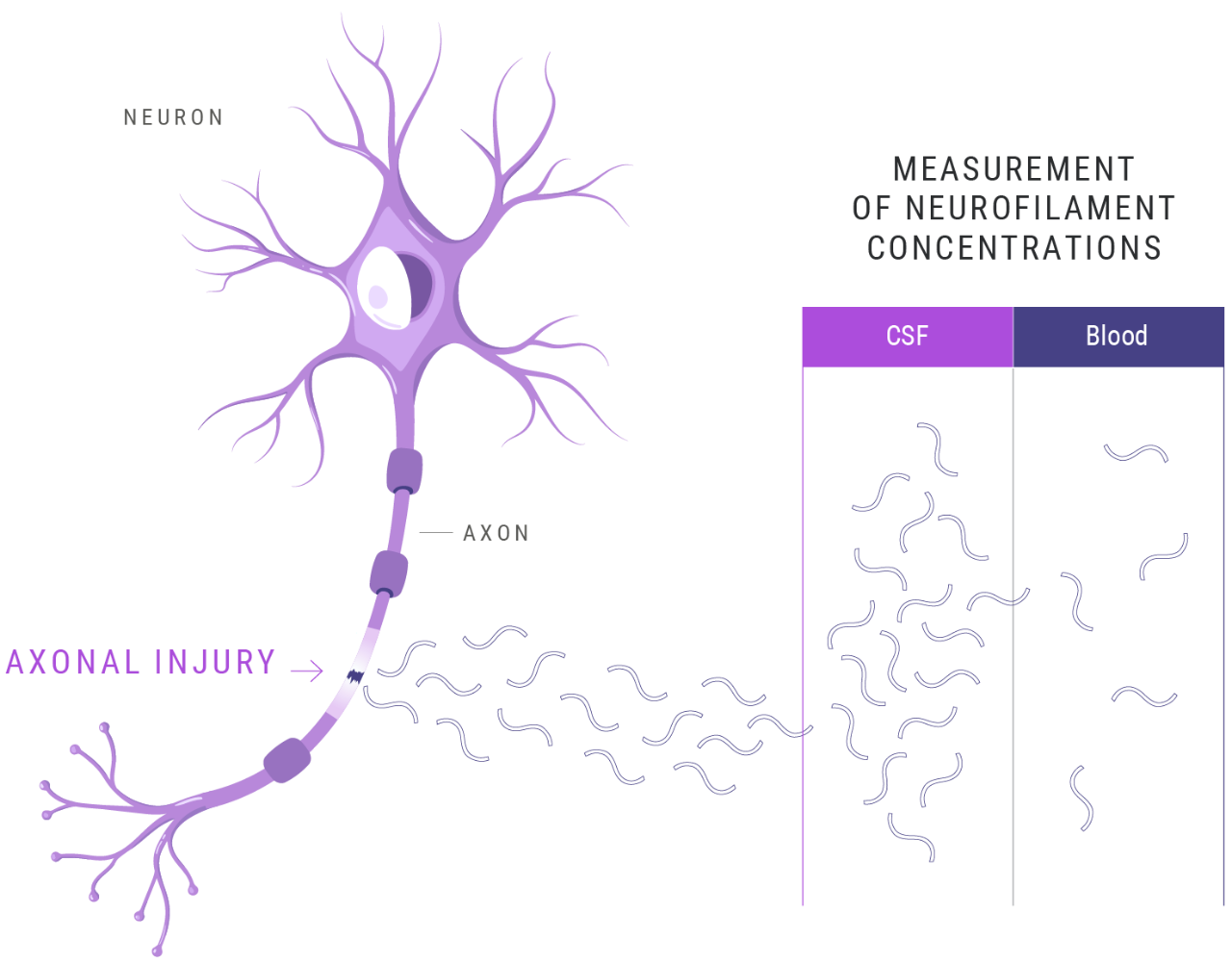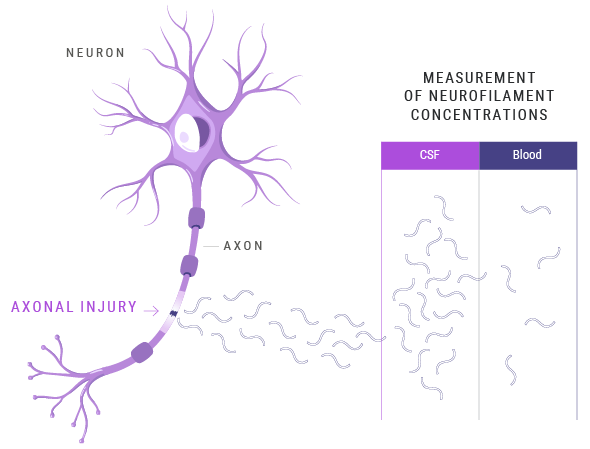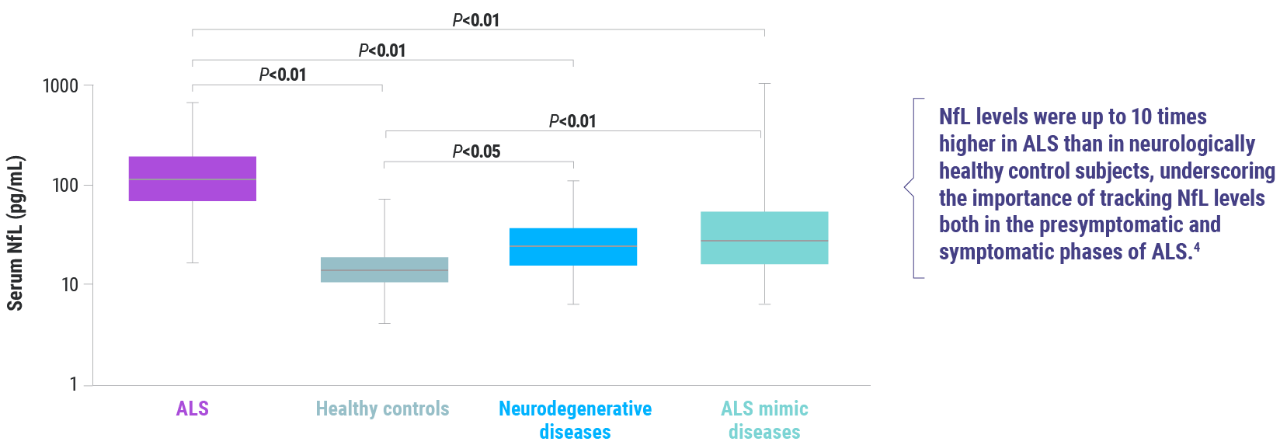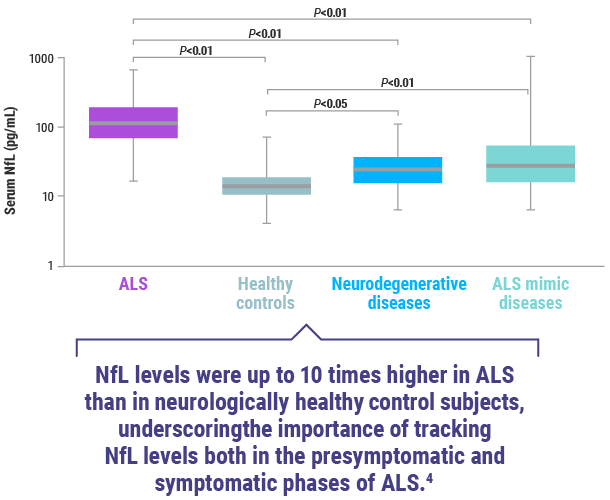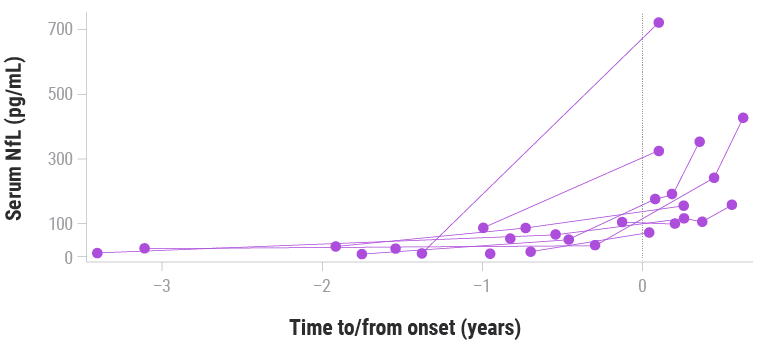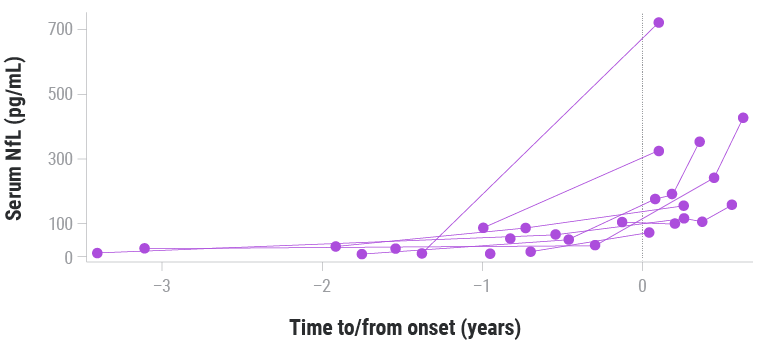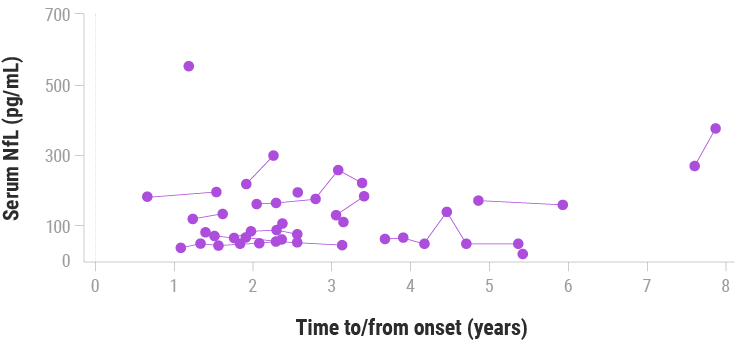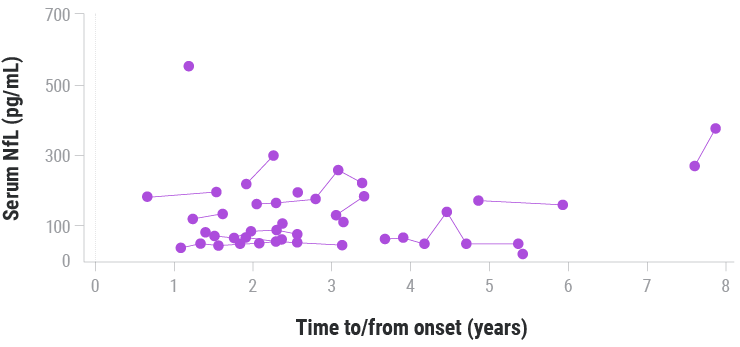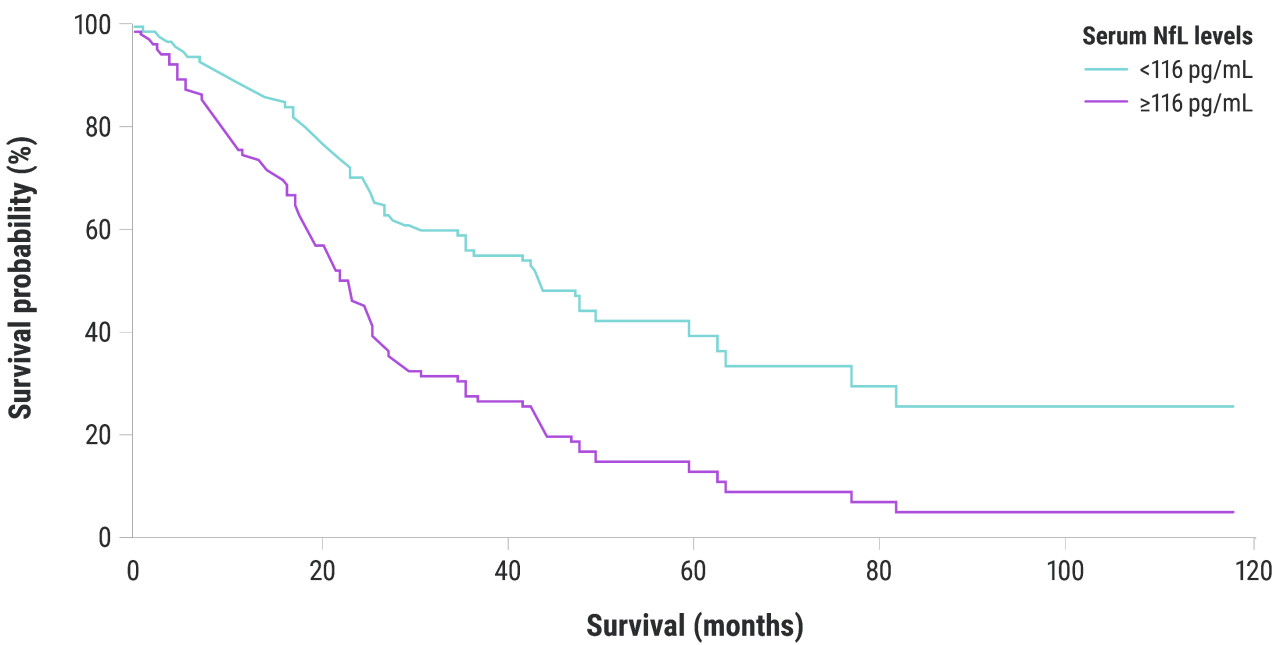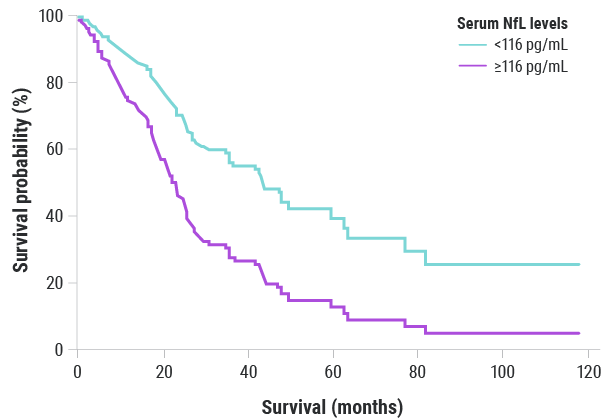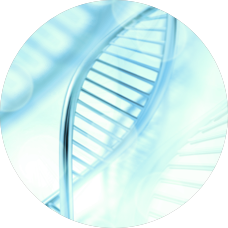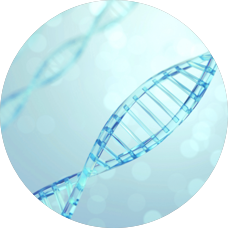Neurofilaments: important biomarkers of disease progression and survival in amyotrophic lateral sclerosis (ALS)1
About ALS / Neurofilaments
Neurofilament levels increase following axonal damage2
Once released, neurofilaments enter the cerebrospinal fluid and blood.
Elevated blood and CSF neurofilament levels have been seen in different neurological conditions characterized by neuroaxonal damage, including Alzheimer’s disease, Parkinson’s disease, multiple sclerosis, and ALS.4-6
NfL levels are among the highest in patients with ALS compared to other neurodegenerative diseases2-4
This is likely because ALS is characterized by a relatively rapid degeneration of motor neurons, where the longest axons in the body are found and that contain relatively large quantities of neurofilament.6
In people living with ALS, serum NfL levels rise presymptomatically—and stay elevated7
In a longitudinal study of 84 asymptomatic carriers of genetic mutations associated with ALS, NfL elevations were detected prior to emergence of clinical signs or symptoms of ALS and continued to rise for at least 6 months after symptom onset, potentially serving as objective markers of structural injury.
Without intervention, neurofilament levels can stay elevated, predicting a decline in patient function and even reduced survival.
Elevated NfL levels have been correlated with the rate of disease progression, including a decline in the ALS Functional Rating Scale—Revised (ALSFRS-R) score8
Neurofilament levels reflect the rate of disability progression in ALS and may be an indicator for longitudinal change in function.9
For every 1-point increase in log serum NfL level, the ALSFRS-R rate of decline is worsened by an additional 0.42 points per month (P<0.001).1
Data were based on log-transformed NfL concentrations.
NfL has been shown to be a strong predictor of survival in ALS10
In a retrospective study of 383 patients diagnosed with ALS between 2009 and 2018, elevated NfL levels were correlated with the rate of disease progression—including decreased patient survival rates.
In a longitudinal study of patients diagnosed with ALS (N=248) NfL was the only variable independently associated with shortened survival in comparison to other biomarkers such as C3, C4, CRP, ferritin, and CK, as well as the ALSFRS-R.9
C=C-terminus; C3=complement C3 protein; C4=complement C4 protein; CRP=C-reactive protein; CK=creatine kinase; CSF=cerebrospinal fluid (CSF); kDa=kilodalton; N=N-terminus; NfH=neurofilament heavy chain; NfL=neurofilament light chain; NfM=neurofilament medium chain.
References: 1. Benatar M, Zhang L, Wang L, et al. Validation of serum neurofilaments as prognostic and potential pharmacodynamic biomarkers for ALS. Neurology. 2020;95(1):e59-e69. 2. Heckler I, Venkataraman I. Phosphorylated neurofilament heavy chain: a potential diagnostic biomarker in amyotrophic lateral sclerosis. J Neurophysiol. 2022;127(3):737-745. 3. Petzold A. Neurofilament phosphoforms: surrogate markers for axonal injury, degeneration and loss. J Neurol Sci. 2005;233(12):183-198. 4. Falzone YM, Domi T, Mandelli A, et al. Integrated evaluation of a panel of neurochemical biomarkers to optimize diagnosis and prognosis in amyotrophic lateral sclerosis. Eur J Neurol. 2022;29(7):1930-1939. 5. Falzone YM, Domi T, Mandelli A, et al. Integrated evaluation of a panel of neurochemical biomarkers to optimize diagnosis and prognosis in amyotrophic lateral sclerosis: supplementary materials. Eur J Neurol. 2022;29(7):1930-1939. Accessed July 17, 2023. https://www.ncbi.nlm.nih.gov/pmc/articles/PMC9314044/ 6. Verde F, Otto M, Silani V. Neurofilament light chain as biomarker for amyotrophic lateral sclerosis and frontotemporal dementia. Front Neurosci. 2021;15:679199. 7. Benatar M, Wuu J, Andersen PM, Lombardi V, Malaspina A. Neurofilament light: a candidate biomarker of presymptomatic amyotrophic lateral sclerosis and phenoconversion. Ann Neurol. 2018;84(1):130-139. 8. Gaiani A, Martinelli I, Bello L, et al. Diagnostic and prognostic biomarkers in amyotrophic lateral sclerosis: neurofilament light chain levels in definite subtypes of disease. JAMA Neurol. 2017;74(5):525-532. 9. Thompson AG, Gray E, Verber N, et al. Multicentre appraisal of amyotrophic lateral sclerosis biofluid biomarkers shows primacy of blood neurofilament light chain. Brain Commun. 2022;4(1):fcac029. 10. De Schaepdryver M, Lunetta C, Tarlarini C, et al. Neurofilament light chain and C reactive protein explored as predictors of survival in amyotrophic lateral sclerosis. J Neurol Neurosurg Psychiatry. 2020;91(4):436-437.
References: 1. Benatar M, Zhang L, Wang L, et al. Validation of serum neurofilaments as prognostic and potential pharmacodynamic biomarkers for ALS. Neurology. 2020;95(1):e59-e69. 2. Heckler I, Venkataraman I. Phosphorylated neurofilament heavy chain: a potential diagnostic biomarker in amyotrophic lateral sclerosis. J Neurophysiol. 2022;127(3):737-745. 3. Petzold A. Neurofilament phosphoforms: surrogate markers for axonal injury, degeneration and loss. J Neurol Sci. 2005;233(12):183-198. 4. Falzone YM, Domi T, Mandelli A, et al. Integrated evaluation of a panel of neurochemical biomarkers to optimize diagnosis and prognosis in amyotrophic lateral sclerosis. Eur J Neurol. 2022;29(7):1930-1939. 5. Falzone YM, Domi T, Mandelli A, et al. Integrated evaluation of a panel of neurochemical biomarkers to optimize diagnosis and prognosis in amyotrophic lateral sclerosis: supplementary materials. Eur J Neurol. 2022;29(7):1930-1939. Accessed July 17, 2023. https://www.ncbi.nlm.nih.gov/pmc/articles/PMC9314044/ 6. Verde F, Otto M, Silani V. Neurofilament light chain as biomarker for amyotrophic lateral sclerosis and frontotemporal dementia. Front Neurosci. 2021;15:679199. 7. Benatar M, Wuu J, Andersen PM, Lombardi V, Malaspina A. Neurofilament light: a candidate biomarker of presymptomatic amyotrophic lateral sclerosis and phenoconversion. Ann Neurol. 2018;84(1):130-139. 8. Gaiani A, Martinelli I, Bello L, et al. Diagnostic and prognostic biomarkers in amyotrophic lateral sclerosis: neurofilament light chain levels in definite subtypes of disease. JAMA Neurol. 2017;74(5):525-532. 9. Thompson AG, Gray E, Verber N, et al. Multicentre appraisal of amyotrophic lateral sclerosis biofluid biomarkers shows primacy of blood neurofilament light chain. Brain Commun. 2022;4(1):fcac029. 10. De Schaepdryver M, Lunetta C, Tarlarini C, et al. Neurofilament light chain and C reactive protein explored as predictors of survival in amyotrophic lateral sclerosis. J Neurol Neurosurg Psychiatry. 2020;91(4):436-437.






